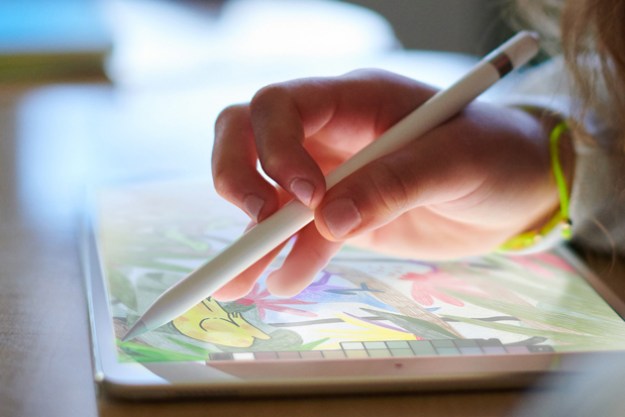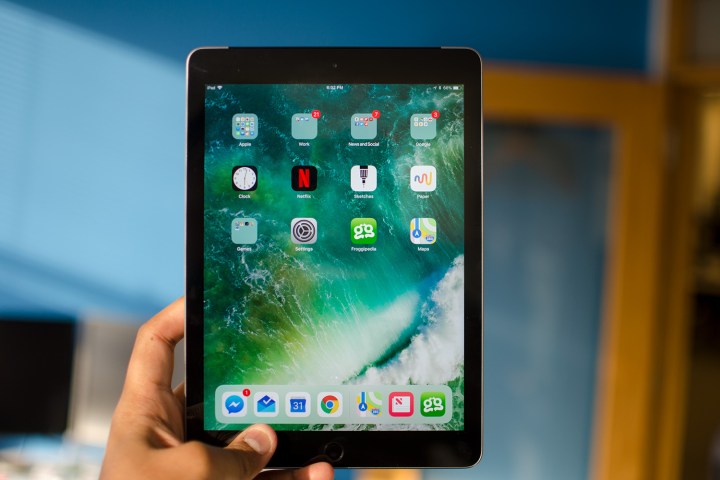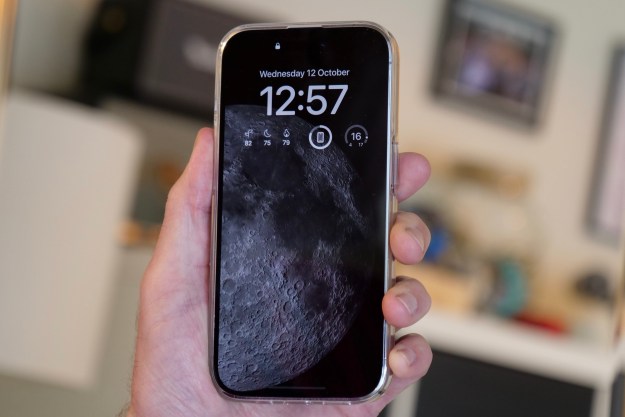
- Pencil is fast to react
- Speedy performance
- Affordable
- Good display
- Long battery life
- Dull design
- Speakers are a little weak
The iPhone X may have been a drastic and gutsy jump in Apple’s smartphone lineup, but the company is sticking to its safe, winning formula with the latest iPad. It may not be as exciting as Apple’s flagship phone, but the 2018 iPad easily retains its title as the best tablet, while managing to still be quite affordable.
The Apple iPad 9.7-inch won our award for the best products of the year. Make sure and check out all our other selections for Best Products of 2018.
Unchanged design, good display
Put the new iPad alongside its predecessors, and it will be tough to spot major visual differences. It’s a functional design, but in 2018 the iPad looks dull and unattractive. The thick bezels surrounding the 9.7-inch screen are everything we’re moving away from in the mobile industry; and while we still need some edges around the display so we can hold the tablet, it would have been nice to see them slightly shaved down.
Everything else is the exact same as last year’s iPad — from the dimensions (9.4 x 6.6 x 0.29 inches) and the 1.03 pound weight, to the Touch ID home button, and bottom-firing stereo speakers. The sleep/wake key resides at the top of the tablet (when held in portrait), and next to it on the right edge is the volume rocker. The Lightning port sits in between the speakers at the bottom.
The bottom-firing speakers, like the 2017 iPad, don’t get as loud as we’d like. They’re not room-filling, and the audio is a little tinny. It’s perfectly adequate for watching YouTube videos and films, but we’d recommend connecting a Bluetooth speaker to this device for a much better music-listening experience.
The iPad feels like it should cost more than $330.
Our review model is the cellular version of the new iPad, which costs a little more, and there’s a SIM card slot on the same edge as the volume buttons. It’s also easier to distinguish because of the black bar on the rear of the device. Speaking of the back, it’s exactly what you’d expect with the Apple logo, the iPad name, and a flush camera on the top left.
The Retina screen has a 2,048 x 1,536-pixel resolution (264 pixels-per-inch), and while it’s not as high resolution as other tablets, we had no problems with display quality. The screen looks sharp, has vibrant colors, and it’s bright enough to view outside in daylight. The blacks aren’t as inky as we’d like — you’ll need an OLED screen for that — but we’re still satisfied with how everything looks on this device. If you want the absolute best media experience on a tablet, your best bet is the iPad Pro, which supports HDR and features a 120hz screen refresh rate.
The iPad feels like it should cost more than $330. It has a nice weight to it, and the aluminum frame makes it feel well-built. The 9.7-inch size means the tablet easy to hold, and it’s compact enough to easily shove into most bags. Our biggest disappointment here is the design — largely because it’s unchanged — and we wish Apple slightly reduced the bezels around the screen. If you were hoping for a major redesign, you may have to wait for the rumored 2018 iPad Pro.
Speedy performance, iOS 11.3 is polished
While much hasn’t changed on the outside, there are a few noteworthy improvements on the inside of the iPad. It’s powered by Apple’s A10 Fusion processor with an embedded M10 coprocessor — the same chip that’s in the iPhone 7 and 7 Plus — which offers a solid performance and graphics improvement over last year’s A9 chip. What hasn’t changed is the 2GB of RAM, as well as the 32GB or 128GB storage options.
There were absolutely no issues with performance on this tablet with everyday tasks. Apps opened quickly, and moving throughout iOS 11.3 felt fluid and speedy. Games ran without any hitches at all — including Civilization VI, though we did see a few frame drops on titles such as Inside when there was a lot of action on the screen.

We do wish Apple utilized 3D Touch on the iPad, as we’ve grown accustomed to using it on our phones, and it would have been nice to see the second-generation version of Touch ID. Apple stuck the first-generation version of its fingerprint authentication technology in the iPad — likely to save costs — and it’s noticeably slower.
Regardless, most people will be more than satisfied with how this iPad performs. It helps that iOS 11.3 makes using the tablet an absolute pleasure. The floating dock is a swipe away at all times; the Slide Over and Split View makes it easy to drag and drop content between apps — these are all tablet-specific functions that make it really feel like an operating system designed for a larger screen. You won’t find any tablet that comes close to feeling as polished.
iOS 11.3 makes using the iPad an absolute pleasure.
That’s not to say we love everything about iOS — it’s sad to see there’s still no multi-user support. There’s a feature called Shared iPad that has been around for a few years, and it allows multiple people to log into their respective account on one iPad device — sadly, this feature is restricted to schools. An iPad in the home is often used as a device for the whole family, and restricting access to just one account is frustrating. This has been available on Android phones and tablets for a number of years, and it’s time for Apple to add it.
The iPad has an 8-megapixel camera on the rear that’s capable of taking some great photos, but we suggest using your phone, since it likely has a much better camera. The iPad’s camera is handy for scanning documents to mark up or convert into PDFs, though. The front-facing camera only has 1.2 megapixels, and the quality is adequate. We do wish tablet-makers would put the better camera on the front, since it’s the one we use the most for video conferencing and selfies.
Works with Pencil
Apple Pencil support is the biggest reason to upgrade to the new iPad, especially if you’ve ever had the desire to use a stylus on a tablet or phone.

The experience of using the Apple Pencil on the iPad is similar to using it on an iPad Pro — the latter registers the Pencil a little faster, but we didn’t have any problems drawing and writing precisely. Most impressive is Apple’s palm-rejection technology, as the screen didn’t register our resting palms while drawing. It also tracks the amount of pressure you put on the screen with the Pencil, which is handy in a variety of applications.
Apple Pencil support is the biggest reason to upgrade to the new iPad.
The Pencil isn’t for everyone. We prefer to use our fingers to navigate through iOS, but we did appreciate being able to the stylus in drawing apps, and when marking up or signing documents. If you find yourself wanting or doing those kinds of functions often, spending an extra $100 for the accessory is absolutely worth it.
The Pencil also has a few interesting uses in education — we tried an app called Froggipedia, which not only lets you look at a frog’s anatomy through augmented reality (via ARkit), but also lets you dissect a frog with the Pencil as a make-believe scalpel. It even makes sure you apply the right amount of pressure, so you don’t damage any organs.
The iPad for education?
The Pencil does have a place in the classroom, but it’s too expensive and not as rugged as it needs to be to withstand children. The cap is easy to lose, and it’s easy (and painful) to see children accidentally breaking the Pencil off the iPad when it’s charging. Logitech is making a stylus called the Crayon in collaboration with Apple that’s sturdier, and it costs $50. The downside is it doesn’t have pressure sensors.
We wish the iPad supported Apple’s Smart Connector — a port on the iPad Pro models that lets you easily connect the tablet to accessories like Apple’s Smart Keyboard. Logitech makes a rugged keyboard case for the iPad (for schools only), but it costs $100, dramatically increasing the overall cost. The cost of an iPad, along with a keyboard and Crayon or Pencil, sits between $450 to $500 (with the education discount).
It’s tough to see how the iPad can compete with lower-priced Chromebooks that most of the time come with keyboards — which makes any device far more versatile — but Apple’s strategy is to win with software. ARKit support lets kids develop programs in augmented reality; the iWork suite supports the Pencil; a new Schoolwork app helps teachers create assignments. Apple has launched a wide number of initiatives for teachers and students, but we’re not so sure if those are the kinds of things teachers need right now in this underfunded education climate. We’ll have to see how teachers take to these upcoming additions when the 2018-2019 school year kicks off.
Battery life
The iPad continues to be the everyman’s tablet.
After continuous gaming, browsing, and YouTube binging for 5 hours, the iPad only dipped to 61 percent. This tablet will last you a while, especially if you’re only using it for a few hours in a day. Standby time is equally impressive — we left it on over the weekend at 60 percent charge, and it had 54 percent remaining on Monday morning.
There’s no wireless or fast charging, which are features we’d love to see in the upcoming iPad Pro at the least.
Price, availability, and warranty information
The 32GB iPad will set you back $330 for the Wi-Fi model, and $450 for the Wi-Fi and Cellular option. It comes in Space Gray, silver, and gold. It’s available now in stores and online — you can check out our buying guide for more details.
Apple offers a one-year limited warranty on the iPad, which covers manufacturing defects, but you also get 90 days of complimentary tech support. You can pay $69 to nab AppleCare+, which extends the warranty to two years from the date of purchase, and protects the device from two incidents of accidental coverage (though those are subject to a $50 service fee). You do get 24/7 access to Apple tech experts via chat or phone.
Our Take
The best tablet is the iPad. Period. For $330, it can handle a variety of tasks you throw at it, has a good-looking display, and best of all works with the fantastic Pencil. It continues to be the everyman’s tablet.
Is there a better alternative?
Yes. The iPad Pro. But it’s for serious creatives working with video- and photo-editing apps, as well as professionals running intensive tasks. The 10.5-inch iPad Pro starts at $650, so it’s quite a jump. Most people won’t need this souped-up tablet, which is why we recommend the iPad.
Are there cheaper tablets? Yes, but they won’t provide the same software experience as the iPad. Amazon’s Fire tablets are solid devices for their extremely low prices, but they come with a lot of compromises.
The Samsung Galaxy Tab S3 is our pick as the best Android tablet, but it’s more expensive than this iPad. The Huawei MediaPad M5 (review to come) will likely be a solid alternative, but again, it’s priced higher and it’s not sold in the U.S. yet. Check out our guide to the best tablets for more.
How long will it last?
The iPad will last you three to four years at minimum. Apple delivers software updates to its products quite a few years after the launch date, so expect to receive the next few versions of iOS. The iPad has an aluminum body, but the front screen is glass — you’ll need a case or cover to keep it fully protected.
Should you buy it?
Yes. If you’re in the market for an large-screen device — for work or play — the iPad is your best choice.
Editors' Recommendations
- No, we weren’t expecting this with the revamped iPad Pro
- The best tablets in 2024: top 11 tablets you can buy now
- The best iPads in 2024: the 5 best ones you should buy
- An Apple insider just revealed how iOS 18’s AI features will work
- The most common Skype problems and how to fix them







